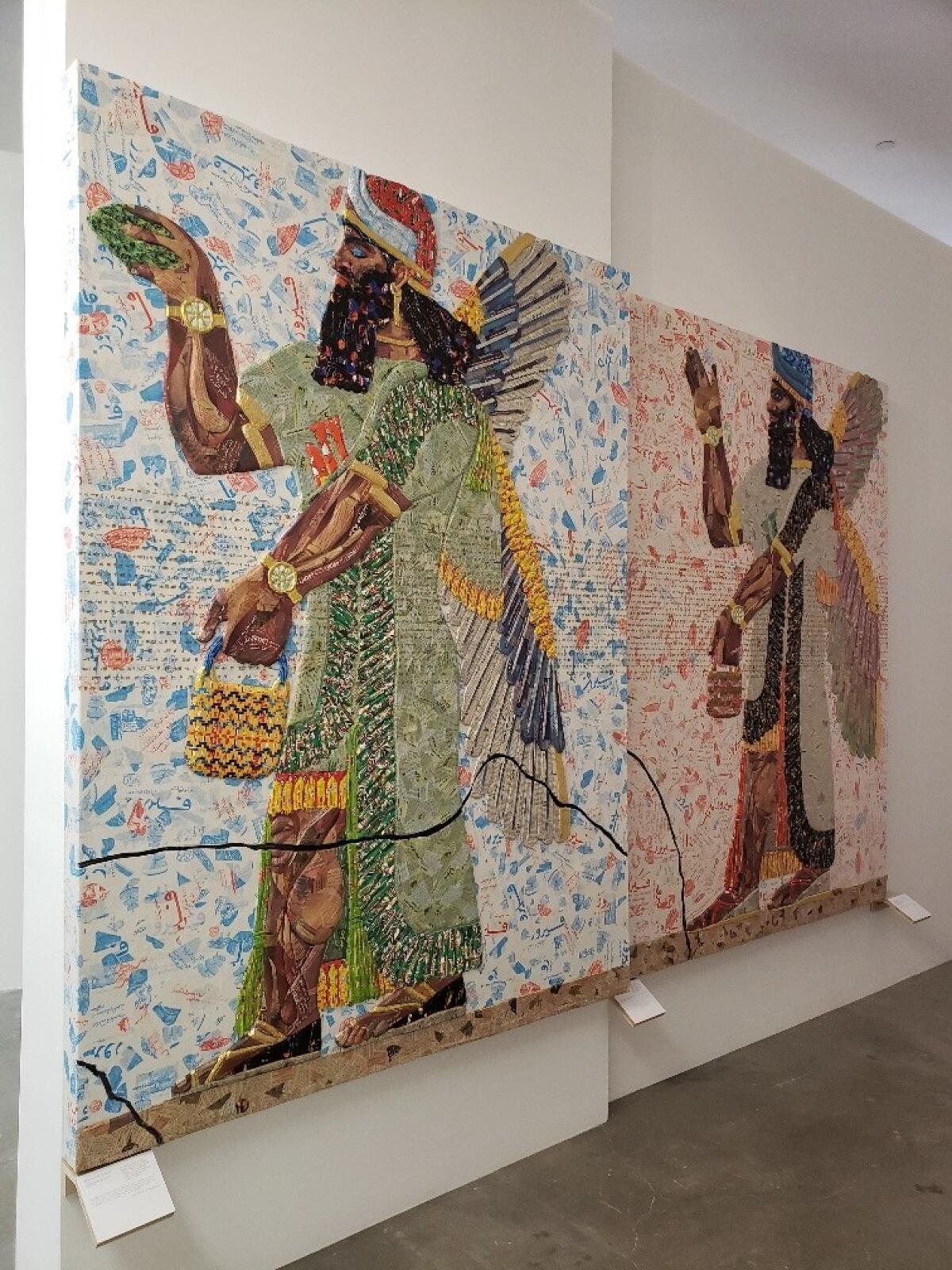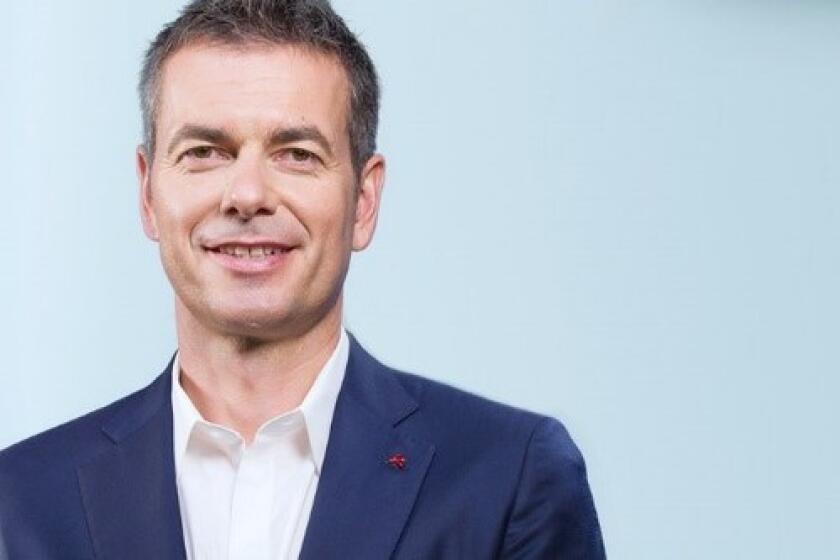Review: Michael Rakowitz remakes looted Iraqi antiquities with a modern message
- Share via
What counts as a cultural artifact? Chicago-based artist Michael Rakowitz turns the concept inside-out.
A rudimentary plywood table at the entrance to the gallery at REDCAT holds an unassuming display of a couple dozen cultural artifacts, each one neatly labeled as hailing from Palmyra, Damascus, Aleppo or another archaic Middle East site. The forms represent ancient Mesopotamian objects — a column’s chunky capital, its shape reminiscent of a trimmed palm, or a Sumerian votive figure whose hands are prayerfully folded across its chest.
While the subjects are ancient and foreign, however, these artifacts are brand new and domestic. Rakowitz has been making surrogates for lost or destroyed sculptures, many looted from Baghdad’s irreplaceable Iraq National Museum. The epic destruction was one of countless disastrous results of the unconscionable American invasion in 2003.
These artifacts embody “us, today,” not “them, back then.”
Some sculptures are collaged with colorful pieces of snipped metal, most from industrially fabricated commercial products. The technique, similar to the one Tony Berlant began to develop for his “House” sculptures in the mid-1960s, likewise has a familial angle for the chosen material: Rakowitz clads many objects with metal from cans of date syrup — a common Iraqi kitchen item now transformed into a slyly pointed political critique, given the work’s context.
REVIEW: At USC Pacific Asia Museum, portraits of actors done the Tsuruya Kokei way »
“A house with a date palm will never starve” goes an old Arabic proverb. Date seeds have been found deep inside regional cave dwellings occupied 50,000 years ago, while the tree’s leaves today still get woven into baskets, its wood is used for building and the natural fibers are woven into rope.
Industrial Age invaders of the Middle East, however, have been more interested in the oil pooled beneath the desert sand.
In 2003, the Bush administration prepared detailed plans for safeguarding Iraq’s oil ministry during the tumultuous six weeks of the invasion; but, despite advance pleas, the clueless American government made no arrangements for securing the museum, one of humanity’s most significant cultural institutions. Rakowitz binds his artifacts to a deep-rooted, more profound cultural history that sustains civilization across millennia.
That theme expands to monumental scale in seven large collaged panels re-creating 9th century BC carved reliefs from the Northwest Palace of Nimrud, southeast of Mosul along the Tigris River. The ruins were excavated in the 19th century. Rakowitz’s cramped installation mimics the tight layout of Room Z in the elaborate complex, a narrow passage in one wing that connected to a large courtyard.

Working with a team of assistants, the artist fabricated winged guardians with human heads, animating the larger-than-life and once-painted figures with colorful collage elements clipped from Middle Eastern newspapers, magazines and commercial packaging. Blank spaces left between some of them recall the six reliefs dispersed to art museums in Europe, the United States and India after the palace was excavated; solemn labels chronicle their displaced provenance.
Four years ago, heartbreak happened. Room Z was demolished by ISIS, the fanatical militia group unleashed by the catastrophic U.S.-led invasion.
Abu Bakr Baghdadi, the Sunni terror group’s leader, had called on believers to wage jihad against God’s enemies in an infamous public address from Mosul’s Great Mosque. After video of the event went viral, a debate raged on social media about the make of the flashy wristwatch the self-anointed caliph was seen wearing.
Rolex? Omega? Al-Fajr WA-10S Deluxe, a Swiss model pre-programmed with the correct Muslim prayer times for major world cities? Several of Rakowitz’s demigods sport golden watches amid their sumptuous ancient finery, flaunting a poignant anachronism.
The REDCAT show is Rakowitz’s L.A. debut. (Last year he unveiled the 12th sculpture commissioned for London’s high-profile “Fourth Plinth” in Trafalgar Square, still on view. In February he withdrew from the 2019 Whitney Biennial in support of staff objections to a trustee with connections to defense manufacturing company Safariland.) In addition to the artifacts, the gallery’s back half features three conceptual art projects from the last 15 years.
DTLA: ArtCenter to take over the space of the abruptly shut Main Museum »
They’re represented through video and photographic documentation, necessary if less immediately engaging than the sculptures. (Absent or uncomfortable seating doesn’t help.) The two videos would be fine to watch if simply posted online, while three big photo murals keyed to the third project feel overblown — a futile stab at filling up empty gallery space, not unlike the gratuitous array of potted palms dotting the room.
The projects themselves are compelling — especially “Return,” which charts a Brooklyn storefront Rakowitz set up in a neighborhood with a sizable population of Iraqi immigrants. (His own maternal grandparents left Baghdad for New York in 1946, fleeing the stressed aftermath of World War II.) The video chronicles his 2004 plan to ship packages to Iraq for free for locals, as well as to import Iraqi dates to the U.S. for the first time since the war.
He ran into some illuminating snags.
For one, even though sanctions had been lifted a year earlier, shippers were nervous about handling any goods labeled “Product of Iraq.” Unusual security precautions, extended stays in port, customs duties and other factors added crushing expenses, which made the cost of importing dates prohibitive.
Rakowitz found that Iraqi producers of date syrup had taken to sending their goods first to neighboring Syria in unmarked cans, then moving it surreptitiously to Lebanon where it could be relabeled for export. In one notable instance, jars of Basra date molasses were identified as a product of the Netherlands — not because any of it was produced there, but only because the company had Dutch offices.
“Return” gives wrenching, unexpected form to dislocations that are physical, psychic and emotional, underscored by the eagerness of waiting Brooklyn date-shoppers to finally get a literal taste of home. Import-export becomes a sharp metaphor for human migration in a corporatized world. The story unfolds as an allegory for the spiraling refugee crisis from the Middle East that has roiled the West ever since the imbecilic Bush adventure.
Rakowitz titled his REDCAT show with a Sumerian fable found written in cuneiform on crumbling clay tablets. “Dispute Between the Tamarisk and the Date Palm” is an unresolvable quarrel about which type of tree is preferable — one that offers shade and myriad practical uses or one that provides sweet sustenance and regal offerings. The ancient quarrel resists a final answer, a lack of closure fitting for a new art that values disquiet and unease.
=====
Michael Rakowitz
Where: REDCAT, 631 W. 2nd St., L.A.
When: Tuesdays-Sundays, through June 2
Admission: Free
Info: (213) 237-2800, redcat.org
More to Read
The biggest entertainment stories
Get our big stories about Hollywood, film, television, music, arts, culture and more right in your inbox as soon as they publish.
You may occasionally receive promotional content from the Los Angeles Times.











